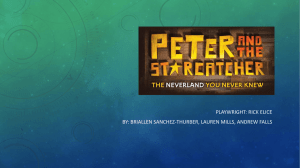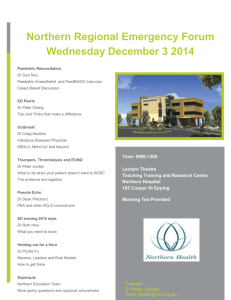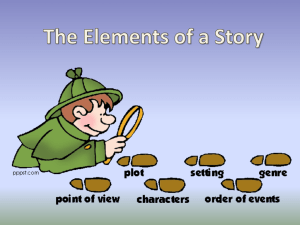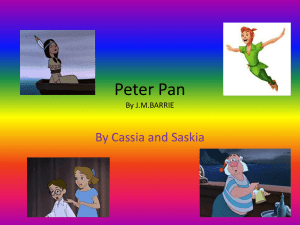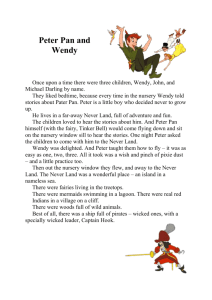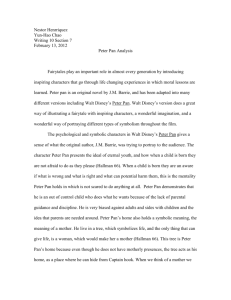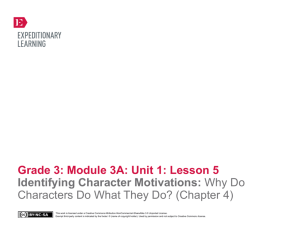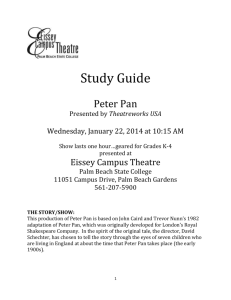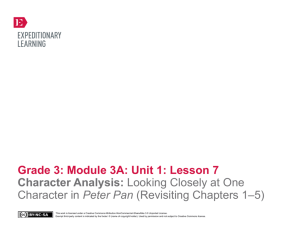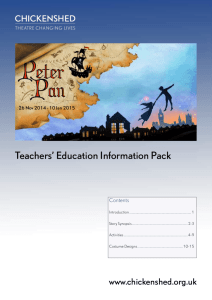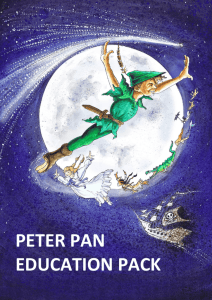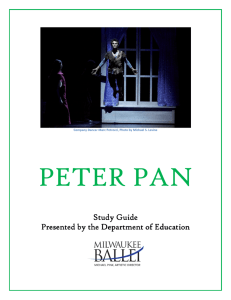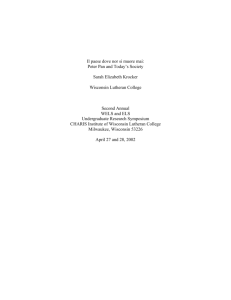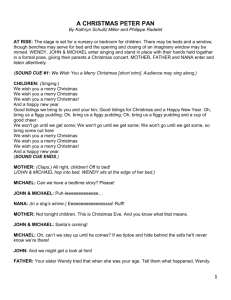Lesso 5 Lesson Plan
advertisement
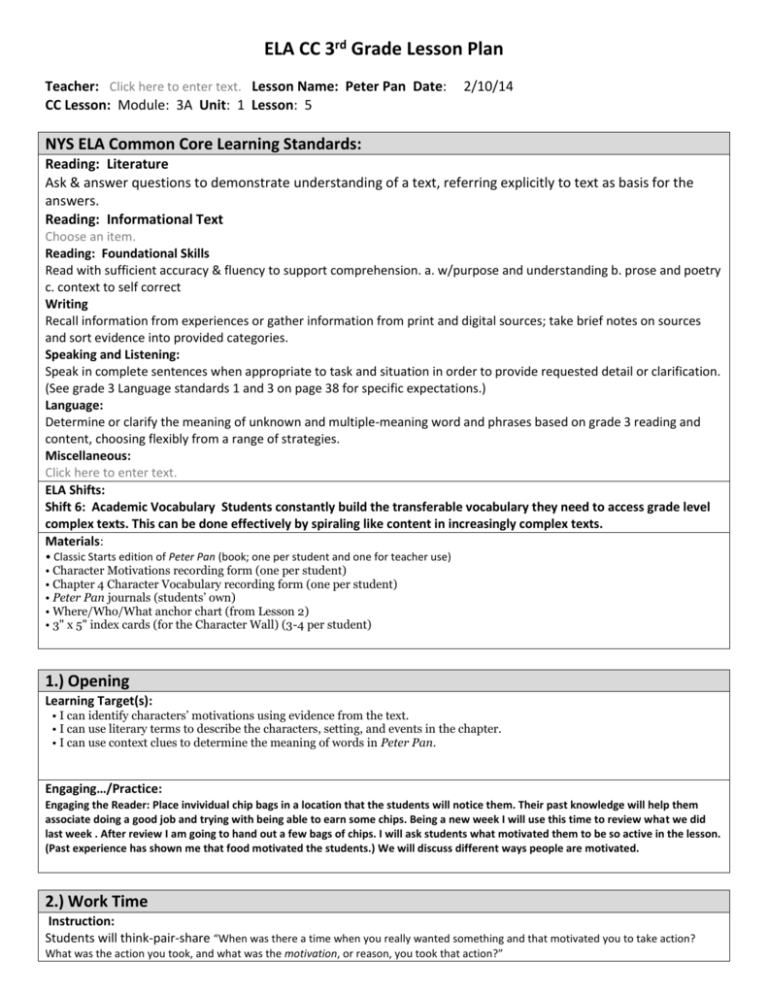
ELA CC 3rd Grade Lesson Plan Teacher: Click here to enter text. Lesson Name: Peter Pan Date: CC Lesson: Module: 3A Unit: 1 Lesson: 5 2/10/14 NYS ELA Common Core Learning Standards: Reading: Literature Ask & answer questions to demonstrate understanding of a text, referring explicitly to text as basis for the answers. Reading: Informational Text Choose an item. Reading: Foundational Skills Read with sufficient accuracy & fluency to support comprehension. a. w/purpose and understanding b. prose and poetry c. context to self correct Writing Recall information from experiences or gather information from print and digital sources; take brief notes on sources and sort evidence into provided categories. Speaking and Listening: Speak in complete sentences when appropriate to task and situation in order to provide requested detail or clarification. (See grade 3 Language standards 1 and 3 on page 38 for specific expectations.) Language: Determine or clarify the meaning of unknown and multiple-meaning word and phrases based on grade 3 reading and content, choosing flexibly from a range of strategies. Miscellaneous: Click here to enter text. ELA Shifts: Shift 6: Academic Vocabulary Students constantly build the transferable vocabulary they need to access grade level complex texts. This can be done effectively by spiraling like content in increasingly complex texts. Materials: • Classic Starts edition of Peter Pan (book; one per student and one for teacher use) • Character Motivations recording form (one per student) • Chapter 4 Character Vocabulary recording form (one per student) • Peter Pan journals (students’ own) • Where/Who/What anchor chart (from Lesson 2) • 3" x 5" index cards (for the Character Wall) (3-4 per student) 1.) Opening Learning Target(s): • I can identify characters’ motivations using evidence from the text. • I can use literary terms to describe the characters, setting, and events in the chapter. • I can use context clues to determine the meaning of words in Peter Pan. Engaging…/Practice: Engaging the Reader: Place invividual chip bags in a location that the students will notice them. Their past knowledge will help them associate doing a good job and trying with being able to earn some chips. Being a new week I will use this time to review what we did last week . After review I am going to hand out a few bags of chips. I will ask students what motivated them to be so active in the lesson. (Past experience has shown me that food motivated the students.) We will discuss different ways people are motivated. 2.) Work Time Instruction: Students will think-pair-share “When was there a time when you really wanted something and that motivated you to take action? What was the action you took, and what was the motivation, or reason, you took that action?” Ask students to open their Peter Pan books to page 17. Tell students that they will follow along as you read, and they should listen for Peter’s motivation to go back to the Darlings’ house. What was his reason? • Read aloud page from the bottom of page 17, beginning with “The children’s room …” and ending at the bottom of page 18 (“… and she sat up in bed”). After reading, ask students to Think-Pair-Share: * “What was Peter’s motivation for returning to the Darlings’ house?” • Share out whole group. Add Peter’s motivation to the Character Motivations anchor chart. • Ask students to Think-Pair-Share a second time: * “What specific evidence on pages 17 and 18 makes you believe that this was his motivation?” Add evidence to the Character Motivations anchor chart. Listen for shares such as: “On page 18, it says ‘Tink?’ he called softly. ‘Is my shadow in that jug?’” or “On page 18 it says, ‘Peter threw open the drawers, piling the clothes in a heap on the floor, and found his shadow.’” Both of these examples show that Peter came back to find his shadow. B. Read-aloud: Introducing Chapter 4 (5 minutes) • Ask students to open their Peter Pan books to Chapter 4, page 26. Invite them to read along as you read aloud pages 26 and 27. The purpose of this read-aloud is to engage students and to model fluent reading. Therefore there should be no pauses for discussion, explanation, or questioning. Independent Reading: Focus on Characters’ Motivations in Chapter 4 (15 minutes) • Distribute the Character Motivations recording formto students. • Tell students that today they will read Chapter 4 of their Peter Pan books, starting back at the beginning of the chapter. While reading, they should focus their attention on the actions characters take and the reasons or motivations for why they take these actions. Tell them they will focus on a few actions, listed in the “Character Action” column of their recording form. D. Small Group Discussion and Chapter 4 Character Vocabulary (15 minutes) • Combine two partnerships to form groups of four. Remind students of the classroom expectations for discussion before they begin. Ask students to share the character motivations they identified as well as the evidence they used to support their thinking. Circulate and support students in their discussion. Differentiation: Click here to enter text. Groups: Click here to enter text. 3.) Closing, Assessment, Homework Closing/Exit Ticket/Homework: Closing: /Who/What Anchor Chart -As students share ideas for the “What” column of this anchor chart, think aloud to make a clear connection between what a character does and his or her motivation for doing it. This will help students to understand the deep thinking they are doing about characters and their actions. “As I write that Wendy [Who] decided to go to Neverland [What], I am also thinking about Wendy’s motivation, or why she took that action. She wants to see all the fantastical creatures who live in this place. I think that would motivate me too! This helps me to better understand Wendy as a character when I think about it this way.” Homework:Reread your favorite page from Chapter 4, either by yourself, or aloud to someone at home. Focus on an action that a character took on that page and discuss the motivation the character had. Why did he or she do what he or she did?
